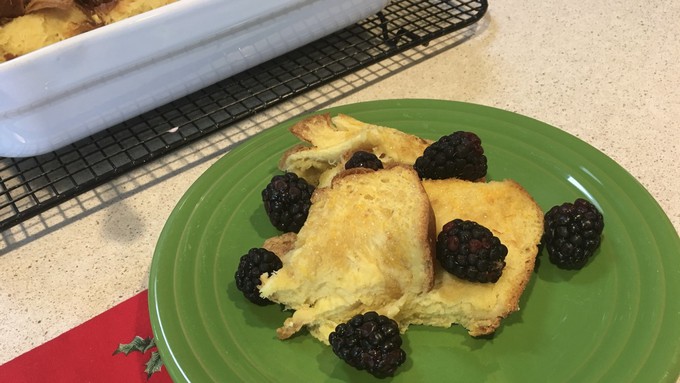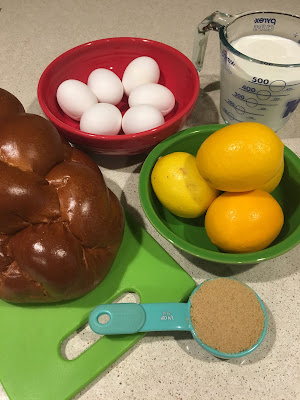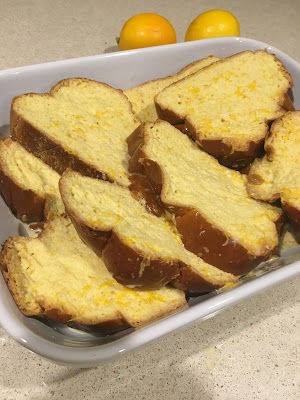
Recipe: Brighten a winter morning with a citrusy baked main dish

Baking French toast is so much easier than standing at the stove, turning each piece. Kathy Morrison
Winter's golden citrus is just showing up at farmers markets and produce sections. Maybe in your garden, too, since the Meyer lemon is such a popular tree to grow in California.
My tiny container tree never produces many lemons, but for years I could count on one co-worker or another bringing in bags or boxes of the lovely floral citrus from a backyard tree. I took as many as I dared, because they are a great fruit for cooking and baking. I'm not alone: Professional chefs love this lemon for its smooth, edible skin and its sweet, rather than tart, flavor profile.
Meyer lemons are named for Frank N. Meyer, the USDA explorer who found them in China and brought them to California in the early 20th century. The original Meyer -- believed to be a cross between a mandarin and a tart lemon -- was later found to be a symptomless carrier of viruses fatal to citrus fruit, and most of the trees were destroyed.

However, a virus-free stock was discovered. It was later certified by the University of California and became the "improved" Meyer lemon that we all grow and love now.
With Christmas approaching, I looked for a recipe that would work for Christmas breakfast or any holiday gathering when you don't want to stand over the stove while everyone else is relaxing or opening presents.
Baked French toast fits that bill, because it is prepped the night before and then popped into the oven the next morning. About 45 minutes later, you have a great breakfast dish that pairs beautifully with berries.
You can gild the lily and add powdered sugar and syrup, but this French toast is delicious without any of that.
The recipe is adapted slightly from Williams-Sonoma. I used the recommended challah bread, but it also would work with thick slices of brioche loaf (Trader Joe's sells an excellent version) or an artisan sourdough round. Just make sure the bread isn't too fresh -- if it is, slice it at least an hour ahead of preparation and let it sit out, or put the slices on a cookie sheet and pop them into a barely warm oven for half an hour or so. The bread will soak up the custard much better that way.
Meyer lemon baked French toast
Serves 6 to8
Ingredients:
Unsalted butter for pan
6 eggs, lightly beaten
2 cups half and half or nondairy milk
1 tablespoon

vanilla (see note below)
Grated zest from 2 Meyer lemons
1/4 cup firmly packed light brown sugar
1 16-ounce loaf challah, brioche or other artisan bread, cut into 1-inch slices
Demerara or other crunchy sugar, for sprinkling
For serving, optional:
Powdered sugar
Fresh berries (blackberries are ideal)
Maple syrup
Instructions:
Grease a large casserole dish or 9-by-13-inch baking pan; set aside.
Crack the eggs into a large bowl; beat lightly with a whisk or fork. Beat in the half and half, vanilla, lemon zest and light brown sugar.
Dip one bread slice at a time into the custard mix, turning to coat both sides. If the bread is not absorbing the liquid quickly, let it sit there for 1 or 2 minutes. Put the slices in the prepared pan, overlapping slightly. When all the slices are prepared, pour the remaining custard mix evenly over the bread slices. Cover the pan with aluminum foil and refrigerate, overnight or at least 2 hours.
When ready to bake, preheat oven to 350 degrees. Remove pan from refrigerator and, keeping the foil in place, put the pan on a rack in the center of the oven. Bake for 30 minutes. Remove foil and sprinkle about 1 tablespoon of the coarse sugar over the slices. Continue baking uncovered for 15 more minutes, or until French toast is puffy and the bread slightly brown on top.
Let the dish rest for about 5 minutes. Cut or scoop out the French toast and serve with desired toppings and fruit.
Note: Real vanilla extract is so pricey these days, 1 tablespoon may seem like too much. I gave up on buying it in the store and began making my own extract last year. (I put 4-5 vanilla beans, ordered online, in 1 pint of vodka in a Mason jar, stored in a cool place for as long as it takes to taste of vanilla. Bourbon works, too.) If you don't want to use so much of your precious vanilla in this, I'd recommend using just 1-1/2 teaspoons of extract, augmented with 1-1/2 teaspoons white rum or maple syrup. With all the lemon zest in this, that will be enough.
Comments
0 comments have been posted.Sacramento Digs Gardening to your inbox.
Sites We Like
Garden Checklist for week of May 12
Get your gardening chores and irrigation done early in the day before temperatures rise.
* Plant, plant, plant! It’s prime planting season in the Sacramento area. Time to set out those tomato transplants along with peppers and eggplants. Pinch off any flowers on new transplants to make them concentrate on establishing roots instead of setting premature fruit.
* Direct-seed melons, cucumbers, summer squash, corn, radishes, pumpkins and annual herbs such as basil.
* Harvest cabbage, lettuce, peas and green onions. This heat will cause leafy greens and onions to flower; pick them before they bolt.
* In the flower garden, direct-seed sunflowers, cosmos, salvia, zinnias, marigolds, celosia and asters.
* Plant dahlia tubers. Other perennials to set out include verbena, coreopsis, coneflower and astilbe.
* Transplant petunias, marigolds and perennial flowers such as astilbe, columbine, coneflowers, coreopsis, dahlias, rudbeckia and verbena.
* Keep an eye out for slugs, snails, earwigs and aphids that want to dine on tender new growth.
* Feed summer bloomers with a balanced fertilizer.
* For continued bloom, cut off spent flowers on roses as well as other flowering plants.
* Got fruit trees? If you haven't already done so, thin orchard fruit such as apples, peaches, pears, pluots and plums before they grow too heavy, breaking branches or even splitting the tree. Leave the largest fruit on the branch, culling the smaller ones, and allow for 5 to 6 inches (or a hand's worth) between each fruit.
* Thin grape bunches, again leaving about 6 inches between them. For the remaining bunches, prune off the "tail" end, about the bottom third of the bunch, so that the plant's energy is concentrated in the fruit closest to the branch.
* As spring-flowering shrubs finish blooming, give them a little pruning to shape them, removing old and dead wood. Lightly trim azaleas, fuchsias and marguerites for bushier plants.
* Add mulch to the garden to help keep that precious water from evaporating. Mulch also cuts down on weeds. But don’t let it mound around the stems or trunks of trees or shrubs. Leave about a 6-inch to 1-foot circle to avoid crown rot or other problems.